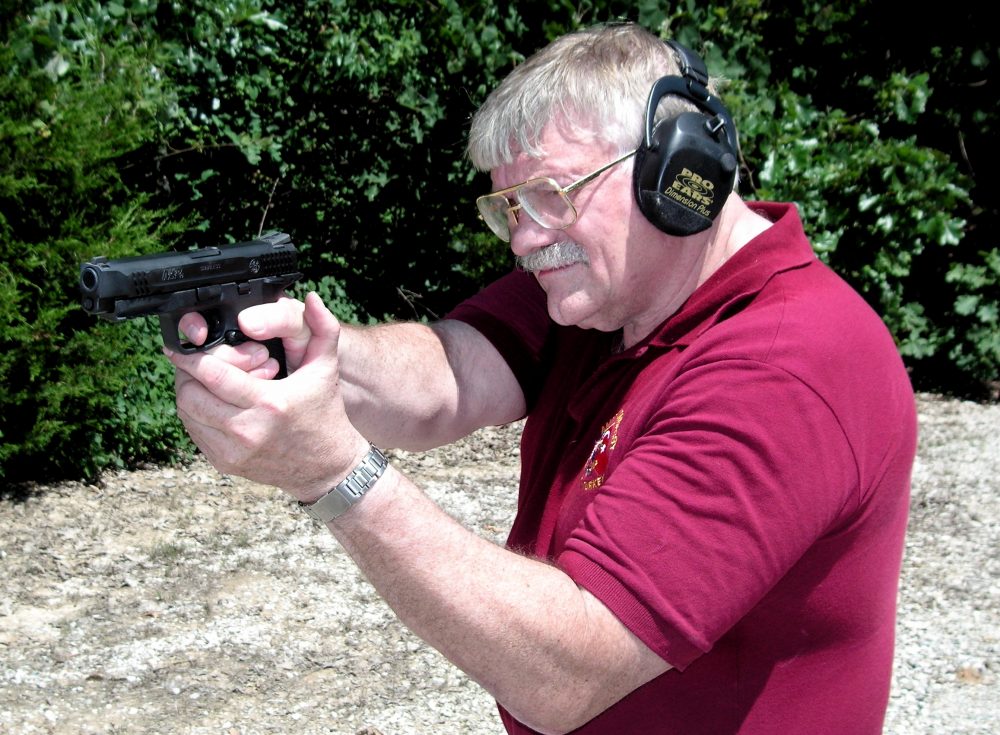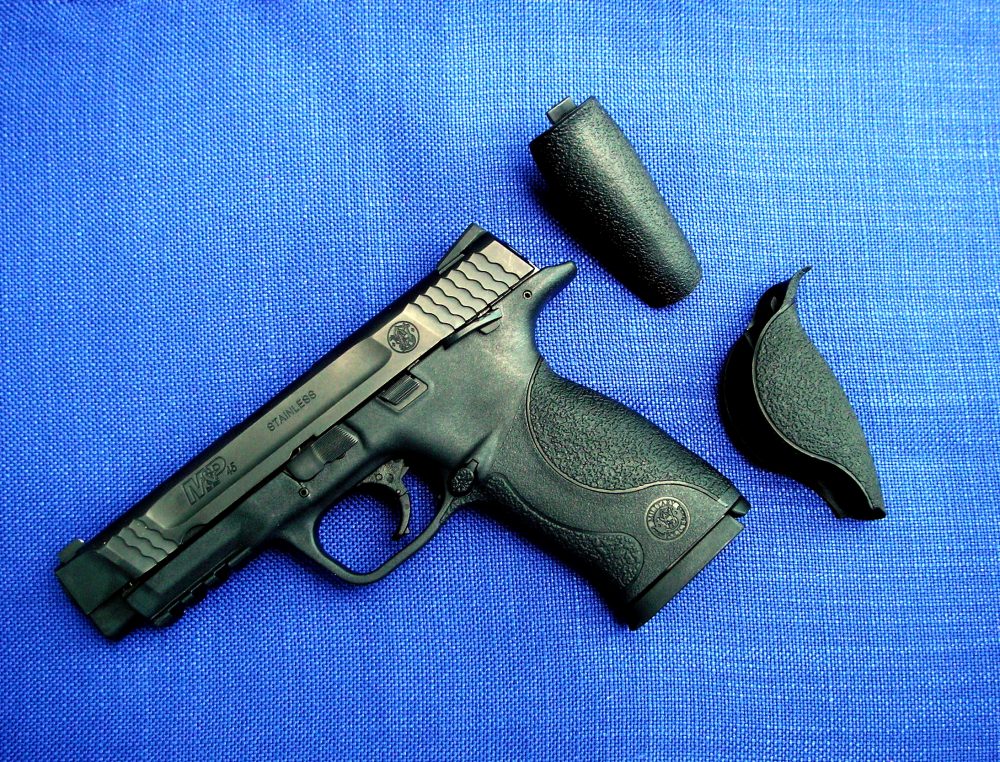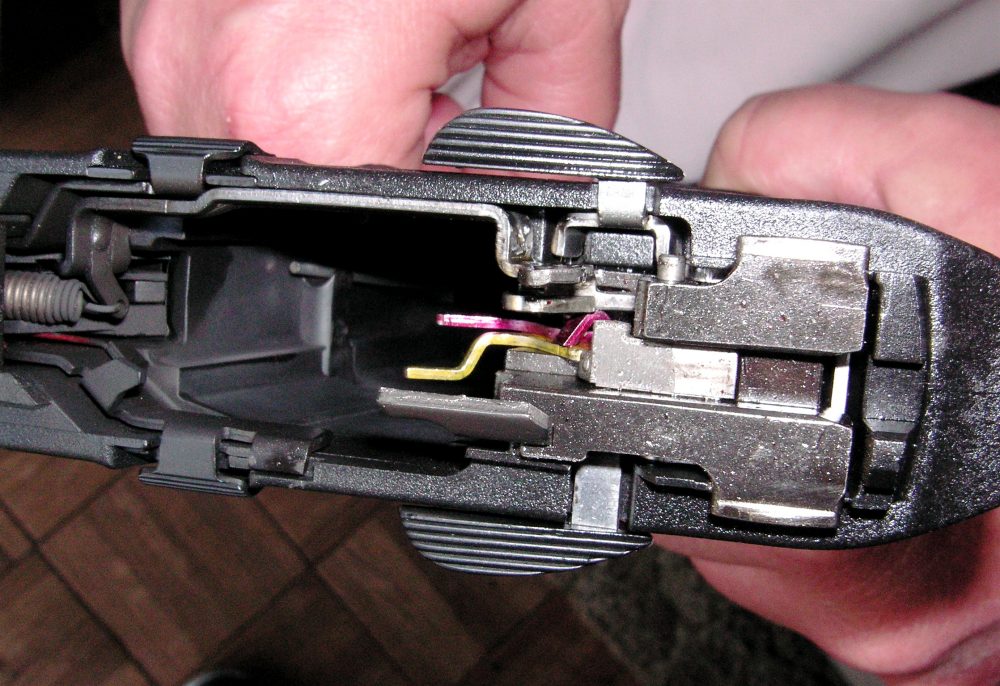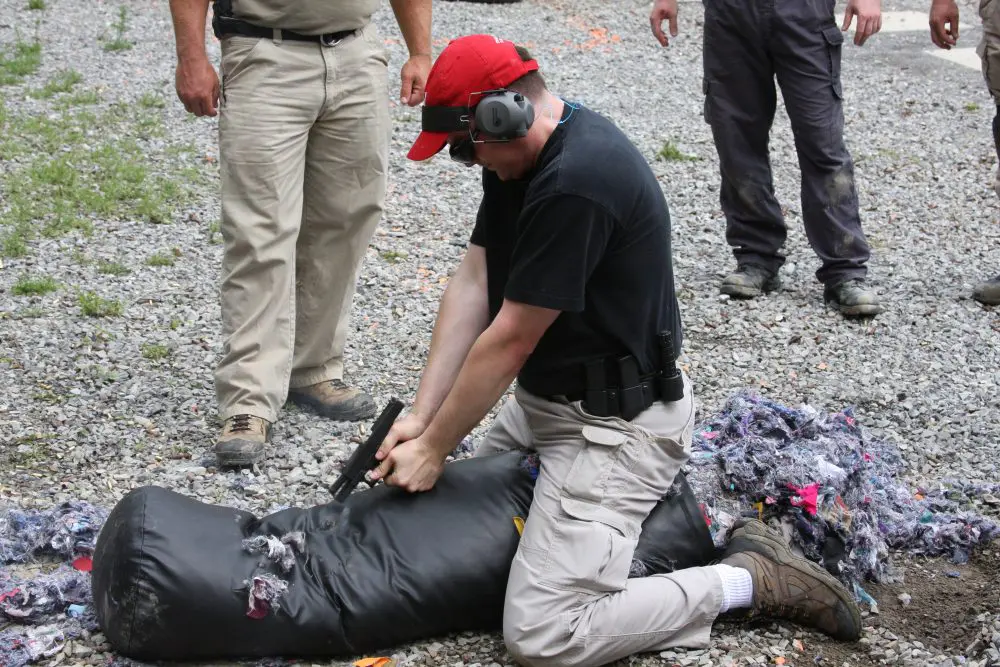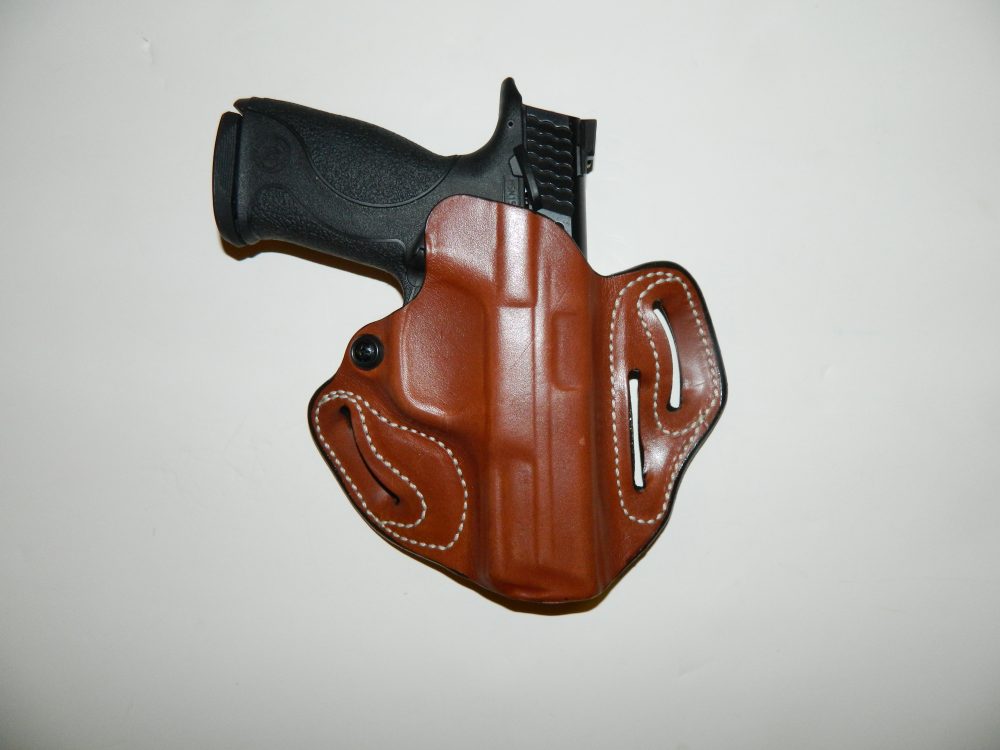I have to admit that I neglected Smith & Wesson’s M&P pistols for the first year or so after they were introduced. Oh, I shot a friend’s a couple of times and thought it was a pretty good pistol, but I didn’t really do much more. A few months ago, however, I acquired a 9mm M&P and started shooting it quite a lot. I soon became a convert. One of the greatest attractions for me is that the M&P is a high capacity pistol that doesn’t feel fat. The fact I could switch out the backstrap to get one that felt best sold me as well. I find the trigger pull with Smith & Wesson’s striker-fired action (which many call a double-action but really isn’t) appeals to me as well. In fact, I like my 9mm M&P so much that I’ve been using it for the last few months to test 9mm ammo when I get something new in. I’ve now put over 1,000 rounds through it with a lot of different loads. It has worked fine and shown good accuracy.
M&P .45 is one of most comfortable and fast-handling .45 pistols author has used. Ergonomics are excellent.
That’s where I stood on the Smith & Wesson M&P autoloader until a couple of months ago, when I visited the S&W factory to shoot various new guns. High on the list of those I wanted to try was the .45 version of the M&P designed to meet the on-again, off-again military trial specs. I did shoot one of the dark earth models with the various military features and liked it. The one that really fascinated me, however, was a black model of the same pistol, which is basically the military model without the dark earth frame and threaded barrel. In simple terms, it has the thumb safety specified for the military model and night sights. Smith & Wesson seems to just designate this as an M&P .45 with optional features, but I think of it as more the Military Model for Police.
Note ambidextrous thumb safety and slide release as well as M&P’s segmented trigger.
Admittedly, the Smith & Wesson action does not need the thumb safety. It is entirely safe without the additional safety. I also know that many trainers want pistols as simple to use as possible and dislike thumb safeties. However, I feel there are still real advantages to the thumb safety for some law enforcement users. First, some departments are more accepting of automatic pistols with thumb safeties, though the wide use of Glocks has overcome this fixation to a substantial degree. Many who used S&W autos in the past carried them with the slide mounted safety down and trained themselves to flick it up when they drew. They felt this made it less likely that a boob could snatch their pistol and easily turn it on them. The thumb safety could serve the same purpose. I do feel if one has the gun with the thumb safety, it should always be carried with it on, so flicking it off is a natural move when drawing.
When testing how fast the .45 M&P handles, author quickly fired these eight rounds of Black Hills 230-grain JHP center of mass at 15 yards.
I have friends who actually don’t like night sights, but I do and on a police duty gun they will usually be required; hence, my reason for ordering the M&P .45 with night sights. I want to pay Smith & Wesson a compliment here on the night sights fitted to the M&P. They shoot to point of aim with 230-grain ammunition. I point this out because a substantial portion of the .45 autos I get in to test—especially with night sights—shoot six to eight inches low at 25 yards with 230-grain loads. This is an issue since, if they are low with 230-grain loads, they will be even lower with lighter, faster loads. As a result, the only fix is a lower front sight, and I have spent many hours on the phone or e-mailing trying to get the right front sight so my .45 autos shoot to point of aim. Shooting high can, at least, be adjusted a lot of the time by using loads with lighter bullets. So, kudos to S&W for having night sights that are correct.
Other features of my M&P .45 are the same as the standard .45 M&P. One feature that I especially like is the M&P .45’s size. At 7.75 inches overall length, 5.5 inches high and 1.2 inches wide, it is close enough to the 9mm or .40 M&P that it fits in the same Galco Summer Comfort IWB holster that I use for my 9mm M&P. Empty weight is just under 30 ounces. For a .45 ACP that holds 10+1 rounds, this is a very compact pistol, yet its barrel length is still 4.5 inches.
For law enforcement users, M&P .45 would lend itself to duty tactical use, yet it remains compact enough to carry on soft-clothes assignments or off duty.
Ergonomics are excellent. I like pistols that allow the backstrap to be changed out to fit one’s hand. I probably have about medium-sized hands, but I almost invariably like the way most pistols feel with the smallest backstrap. The .45 M&P is no exception. Whether one gets the ambidextrous thumb safety or not is personal choice, but I like its location, which allows it to be flicked off similar to a 1911-type pistol. The slide release is also ambidextrous, which is actually more useful than an ambidextrous safety sometimes when doing an “injured hand/arm” reloading drill. The mag release button is not ambidextrous, but it may be easily shifted for left-handed shooters. I should also point out that the mag release button is well designed so that it is easily hit for release but does not protrude so much that one hits it inadvertently. I already mentioned that I do not have especially large hands, but I can hit the mag release with my thumb without having to roll the gun in my hand, as is the case with many pistols. For a good hold with wet hands, the grips are textured, but are not uncomfortable at all, even when shooting Cor-Bon or other hotter .45 ACP loads.
I like the slam pads on the magazines that allow the magazine to be readily thrust home but are not cumbersome. My gun came with three magazines, but I believe that is because I ordered the LE package, which has the night sights and three magazines. Normally, the M&P pistols come with two magazines. The loaded chamber indicator, which is an inspection hole atop the chamber, is easily seen.
M&P .45 fits the same Galco Summer Comfort IWB holster Thompson uses with his 9mm M&P.
It’s hard to discuss the Smith & Wesson M&P model without mentioning the oddity of its disassembly procedure. To avoid the problem of attempted disassembly while a round is chambered and the possibility of a round firing when the trigger is pulled as part of the process, Smith & Wesson came up with what I consider a somewhat complicated disassembly procedure. Before the pistol can be disassembled, the slide must be locked to the rear and a lever that locks the sear rotated down 90 degrees. Smith & Wesson shows in their manual the use of the pin, which is removed from the base of the frame when changing backstraps, for rotating this lever into disassembly position. A small screwdriver or knife blade works, too. Once the lever is in the proper position, the frame-mounted take-down lever may be rotated and the slide taken off the front of the frame. The rest of the disassembly is standard. This system strikes me as very un-soldier-proof or cop-proof, especially since a pin that might get lost is involved. I understand the safety and liability issues involved and that Smith & Wesson was trying to force the user to be safe when disassembling the pistol, but I find the system overly complicated. It is really one of the few criticisms I have of the M&P.
Durability is another excellent feature of the M&P .45. The Zytel polymer frame combined with stainless barrel, slide, and other parts, allows it to stand up to hard use without rusting. Add the Melonite finish to blacken the slide and barrel, and it stands up even better. I carried a Performance Center 4566 TSW with Melonite finish for a couple of St. Louis summers in an IWB holster right against my sweaty body, and it still looks like the day I took it out of the box. I expect the same from the .45 M&P.
Choice of three backstraps allows M&P .45 to be tailored to a variety of hand sizes. Smallest backstrap is installed on author’s pistol.
I like pistols with the light rail. I have considered the advantages of a pistol-mounted light versus a handheld one in various tactical situations. I believe sometimes the gun-mounted light is useful and sometimes a light in the hand is better. But I do like pistols that give me the option of mounting a light if I so choose. I will throw in one point here, since I purchased my .45 M&P as an LE Model. Agencies that issue a gun that mounts a light and allow officers to carry the weapon in a duty rig for the combo must train officers to not use the gun with light mounted as their flashlight. Anyone who has been involved with an agency that goes to guns with lights mounted can probably tell horror stories of citizens ending up with guns pointed at them because the officer is “just using the light.” As with many other pistols that use the true Picatinny-type rail, I find for the M&P .45 that the Streamlight TLR-1 goes on very easily.
I mentioned that I was pleased that the night sights on the M&P .45 were on for 230-grain loads. I also find that the white circle around the night sights really helps me acquire them in daylight as well.
Yellow lever must be pushed down to position shown before M&P can be disassembled.
Advertised trigger pull on the M&P .45 is 6.5 pounds, but I have to say that on mine it seems heavier and grittier than on my 9mm M&P. This seemed to have some effect on accuracy at longer ranges. A friend of mine who has a standard .45 M&P tried mine at 25 yards and was consistently shooting groups about an inch larger than with his (i.e., four inches with mine and three inches with his). This really has nothing to do with the thumb safety, since it blocks the trigger bar but doesn’t affect trigger pull weight. Accuracy is certainly more than acceptable on the gun.
In fact, I wanted to do some shooting other than just punching bullseyes and shooting at plates, so I set up a “bad guy” target at 15 yards. I fired eight rounds at center of mass quickly, then moved up to the area below the chin where the spine and throat are located and put two there quickly. I then did a reload and put three rounds in the head. In effect, I did a 13-round zipper! I was pleased with placement of all shots for this drill. Both the 25-yard group and my “zipper” were shot with Black Hills 230-grain JHPs. Since these rounds shot to point of aim, I tended to use them the most for testing, but I also tried some 200-grain Cor-Bon and some 230-grain Blazer. All functioned well. I used the Blazer mostly to shoot at plates between 15 and 35 yards, to check reliability and handling.
M&P .45 disassembled into its basic component parts.
I really like the way the M&P .45 handles. When shooting fast at 15 yards and doing the magazine change, I found that the gun always felt right in my hand even though I had fired less than 100 rounds at that point. The more I shoot it, the better I like it. I would like to see the trigger pull a bit smoother, but that may require shooting in or a trip back to S&W for a trigger job. Overall, I like the gun enough that I am going to shoot it a couple more times, then decide if I might want to start carrying it.
As far as the thumb safety goes, I got it because I could and because I can still use the gun with it off if I so choose. I think if I carry the gun, I will put the thumb safety on because I certainly found it as fast to flick off as the safeties on any of my 1911-type pistols and would want to train myself to always assume it was on. [NOTE: I am not recommending the .45 M&P with safety lever for most readers. The standard model is simpler and removes one operation prior to engaging. I got it because I consider the thumb safety an interesting option.]
The bottom line is that I like the M&P line of pistols and especially like the .45 version—with or without thumb safety.
SOURCES:
Smith & Wesson
Dept. S.W.A.T.
2100 Roosevelt Ave.
Springfield, MA 01104-1698
(800) 331-0852
www.smith-wesson.com
Black Hills Ammunition
Dept. S.W.A.T.
P.O. Box 3090
Rapid City, SD 57709-3090
(605) 348-5150
www.black-hills.com
Cor-Bon
Dept. S.W.A.T.
P.O. Box 369
Sturgis, SD 57785
(800) 626-7266
www.corbon.com
Galco International
Dept. S.W.A.T.
2019 West Quail Ave.
Phoenix, AZ 85027
(800) 874-2526
www.usgalco.com
Streamlight, Inc.
Dept. S.W.A.T.
30 Eaglesville Rd.
Eaglesville, PA 19403
(800) 523-7488
www.streamlight.com

